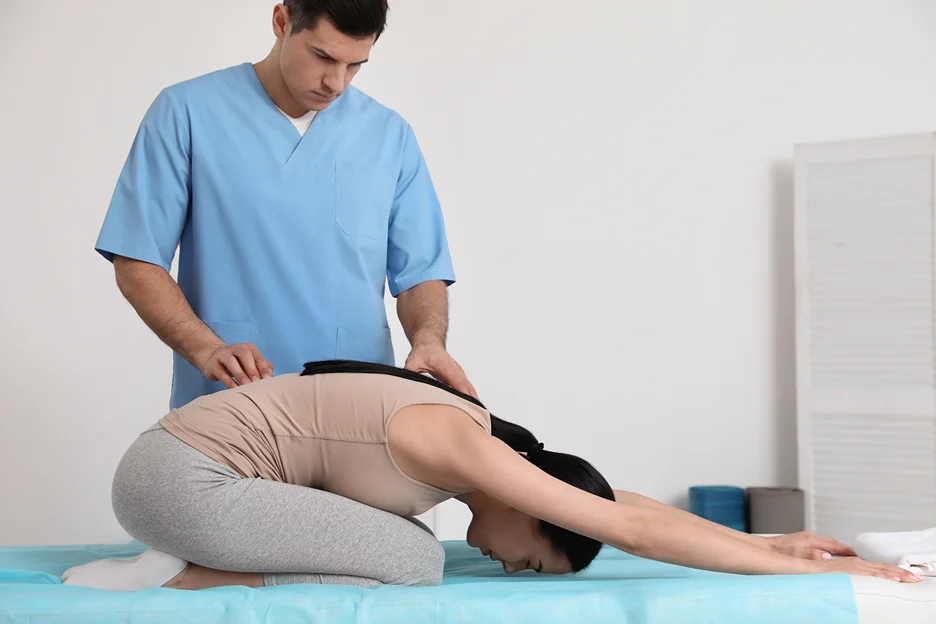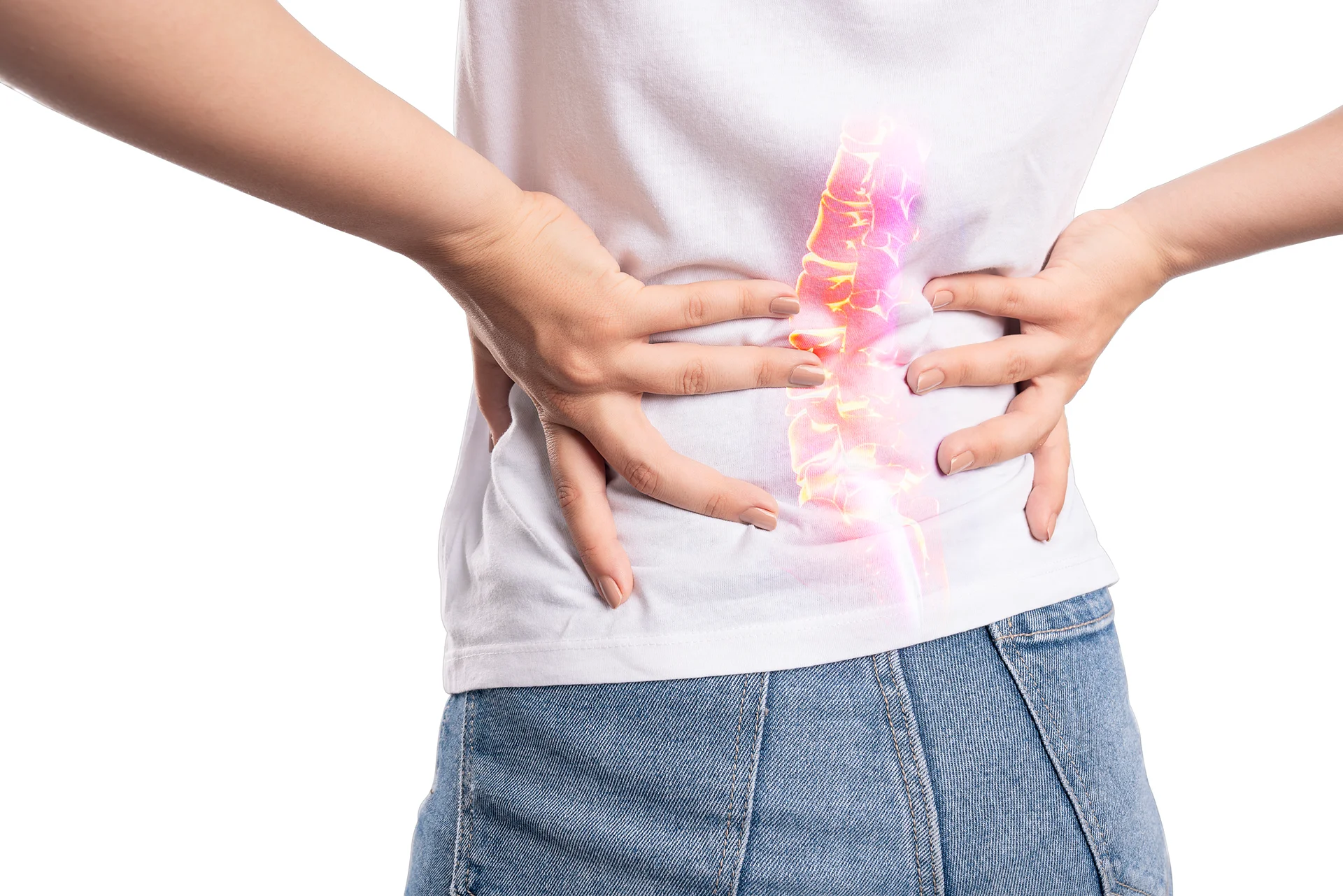If you’re one of the millions of adults suffering from chronic back pain, you know just how debilitating it can be. According to recent statistics, over 20% of the world’s population suffers from chronic back pain.
In this guide, we’ll explore the reasons behind chronic back pain and how it’s identified, but the main focus will be on laying out the many options you have for finally easing all that tension and discomfort you’ve been grappling with.
You’ll gain a deeper understanding of how to manage persistent back discomfort through medical treatments, at-home remedies, exercises, lifestyle changes, and more.
All the Causes of Chronic Back Pain
The hallmark of chronic back pain is that it lasts much longer than “normal” back pain, which resolves within a few weeks. By definition, chronic back pain persists for 12 weeks or longer. This constant or intermittent pain makes it challenging to carry out daily activities and often worsens with movement.
There are several possible causes of chronic back pain:
- Injuries: Accidents, falls, fractures, sprains, tears, and repetitive motions can damage muscles, joints, bones, and nerves. Even after the initial injury heals, you may be left with lasting chronic pain.
- Arthritis: Osteoarthritis and rheumatoid arthritis commonly affect the spine, causing chronic inflammation. The joints degenerate over time, leading to chronic stiffness and may make the pain worse.
- Spinal conditions: Issues with discs, nerves, bones, muscles, and alignment of the spine often result in chronic back pain. Examples are spinal stenosis, herniated discs, scoliosis, and spondylolisthesis.
- Poor posture: Slouching, hunching over, or improper lifting and bending put strain on the back. This can lead to muscle imbalances, misalignment over time, and chronic discomfort.
- Obesity: Excess weight adds more pressure onto the spine and can change the curvature, leading to pain.
- Muscle strain: Lifting heavy objects, sudden movements, overuse, and poor strength/flexibility in core muscles commonly cause muscle tightness, spasms, and chronic pain.
- Sedentary lifestyle: Lack of physical activity weakens back and core muscles, reducing support for the spine.
- Stress: Mental stress prompts muscle tension that can worsen and prolong back pain.
- Genetics: Some causes of back pain like arthritis can run in families. Inherited traits like bone shape may also increase risk.
- Smoking: Smoking impedes blood flow, slowing healing, and potentially contributing to disc degeneration.
- Heavy lifting jobs: Occupations requiring repetitive heavy lifting or manual labor raise injury risk.
- Vibration: Jobs involving prolonged exposure to whole-body vibration such as truck driving are associated with back pain.
- Backpack overloading: Excessively heavy backpacks worn improperly can strain muscles and joints in children and teens.
- Mental health conditions: Issues like depression and anxiety can manifest as unexplained chronic back pain.
If you’re experiencing chronic back pain without a known cause, it’s important to see a doctor for an accurate diagnosis. An older injury or subtle spinal condition may be the culprit. Understanding what’s causing your chronic pain will inform the best treatment approach.
Overview of Symptoms

Chronic back pain can stem from a wide range of underlying conditions, so symptoms can vary significantly for each individual. However, some common signs and characteristics to be aware of include:
- Pain ranging from mild soreness to severe and debilitating
- Aching, stabbing, throbbing, tingling, or numb sensations
- Constant pain or pain that comes and goes over time
- Discomfort localized in the upper, middle, or lower back
- Pain potentially radiating to other areas like the hips, buttocks, legs, shoulders, arms, neck, and ribs
- Stiffness and reduced range of motion when bending, twisting, lifting objects, or changing positions
- Difficulty with activities like standing, walking, or sitting for prolonged periods
- Neurological symptoms like numbness, tingling, weakness, or radiating pain in the limbs, indicating possible nerve compression
- Worsening of pain with movement, breathing, coughing, or certain postures
- Interference with sleep, work, exercise, mood, relationships, and other aspects of daily living
The location, severity, duration, and specific symptoms can help pinpoint the underlying cause of chronic back pain. While generalizations can be made, it’s important to understand that back pain is highly individual. Comprehensive medical evaluation is recommended for accurate diagnosis and treatment.
Types of Chronic Back Pain
When evaluating chronic back pain, doctors will attempt to identify the specific type based on the pain’s origin. The major classifications are:
| Type of Chronic Back Pain | Cause and Description |
| Mechanical/Structural | Caused by issues with the spine, discs, muscles, ligaments, and tendons (e.g. strains, stenosis, degenerative disc disease, scoliosis, spondylolisthesis). |
| Inflammatory | Caused by inflammatory spinal conditions like ankylosing spondylitis or arthritis. |
| Referred | Felt in the back but originating from another area like the kidneys or abdomen. |
| Neuropathic | Caused by nerve compression, inflammation, or damage (e.g. radiculopathy, stenosis, peripheral neuropathy). |
| Myofascial | Caused by muscle or connective tissue tightness/damage, leads to localized pain or trigger points. |
| Nociceptive | Caused by damage to structures like bones, muscles, and ligaments (localized to injury site). |
| Psychogenic | Caused by psychological factors like depression, anxiety, and somatoform disorders. |
How Is It Diagnosed?
To accurately diagnose the cause of chronic back pain, doctors utilize:
- Medical history: Your doctor will ask about symptoms, onset, injury history, and lifestyle factors. Tracking your pain patterns ahead of time is helpful.
- Physical exam: Assessing posture, range of motion, areas of tenderness, muscle tightness, strength, reflexes, and balance provides clues.
- Imaging tests: X-rays, CT scans, and MRI scans create images of the spine and tissues. This lets doctors see issues like arthritis, disc problems, fractures, and bone spurs.
- Other tests: Nerve conduction studies check for nerve damage. Electromyography assesses spinal nerve function. Bone scans help detect fractures.
- Specialist referral: For complex cases, you may be referred to a specialist like a spine surgeon, rheumatologist, neurologist, or pain management physician.
What Treatments Help Manage This Type of Pain?
Treating chronic back pain often involves a multifaceted approach, which may include:
Lifestyle Changes
- Exercise: Low-impact cardio, yoga, Pilates, and gentle strength training improve flexibility, posture, and support for the spine.- Physical therapy: Stretches, exercises, massage, and modalities like ultrasound and electrical stimulation help relieve muscle tension and pain.
- Weight loss: Losing excess weight reduces strain on the back.
- Ergonomic adjustments: Proper sitting, standing, and sleeping postures and positions can provide pain relief.
Medications
- NSAIDs: Anti-inflammatory medications like ibuprofen (Advil) and naproxen (Aleve) alleviate swelling and discomfort.
- Muscle relaxants: These medications ease spasms and tension in the back muscles.
- Nerve pain medications: Drugs like gabapentin (Neurontin) calm neuropathic chronic back pain.
- Antidepressants: Certain tricyclic antidepressants offer pain relief by altering brain chemicals.
- Topical treatments: Creams containing menthol, capsaicin, lidocaine, or NSAIDs can be applied to the localized pain area.
Alternative Therapies
- Massage therapy: Kneading and manipulating soft tissues encourages relaxation and boosts circulation to aid healing.
- Acupuncture: Fine needles placed along the body’s meridians balance energy flow and provide natural pain relief.
- Chiropractic: Spinal manipulation and mobilization help improve alignment and reduce nerve irritation.
- Cognitive behavioral therapy (CBT): CBT teaches coping skills for managing pain and associated stress or depression.
Interventional Procedures
| Procedure | Description |
| Epidural steroid injections | Cortisone is injected into the epidural space around the spinal nerves to decrease inflammation and nerve root irritation/radiculopathy pain. Most effective for this type of pain. |
| Nerve blocks | Numbing injections block the transmission of pain signals from specific nerves. |
| Radiofrequency ablation | Heat applied to nerves interrupts pain signals by disrupting nerve activity. Provides temporary pain relief. |
| Spinal cord stimulation | Electrical pulses modulate nerve activity in the spinal cord to change pain perception and reduce sensations. |
Surgery
Surgery is typically a last resort reserved for severe, debilitating cases not improving with other conservative treatments.
| Surgery Type | Description |
| Discectomy | Removing part of a herniated disc that is pressing on a nerve root to relieve associated radiculopathy and sciatica pain. Performed either open or microscopically. |
| Laminectomy | Removing bone and ligaments pressing on the spinal cord or nerves to create more space and relieve associated pain or numbness. Often done for spinal stenosis. |
| Spinal fusion | Permanently joining vertebrae together for stability and to reduce pain from degenerative disc disease or spondylolisthesis. Over time, may lead to more stiffness. |
| Artificial disc replacement | Removing damaged discs and implanting artificial discs to maintain spine flexibility and mobility compared to fusion. Long-term outcomes are still being studied. |
| Foraminotomy | Removing bone around the foramen to relieve a pinched nerve. Similar purpose to laminectomy but is less invasive. |
What Can I Do to Manage My Chronic Back Pain at Home?
- Apply heat or ice packs: Heat loosens muscles while ice diminishes inflammation and swelling. Alternate between the two for 20 minutes at a time.
- Maintain proper posture: Whether sitting, standing, walking, or lying down, keep your back aligned and supported. Avoid hunching or slouching.
- Do gentle back stretches and exercises: Start slow, especially if your pain is severe. Simple yoga poses, Pilates moves, and targeted stretches boost flexibility.
- Modify activities: Avoid heavy lifting, repetitive motions, and prolonged stationary positions. Take frequent breaks and adjust movements to reduce strain.
- Manage stress: Chronic pain can trigger depression and anxiety. Relaxation techniques like deep breathing, meditation, journaling, or enjoying hobbies curb stress.
- Adjust sleep habits: Stick to a regular sleep schedule and opt for a medium-firm mattress that supports spinal alignment. Side sleeping with a pillow between knees also helps.
- Wear supportive footwear: Shoes with arch support, cushioning, and a low heel reduce pressure on the lower back.
- Watch your weight: Shedding extra pounds minimizes load and strain on the spine to ease pain.
- Make dietary changes: Foods like leafy greens, salmon, and blueberries fight inflammation. Avoid processed foods that promote it.
- Consider supplements: Anti-inflammatory herbs like turmeric, boswellia, and omega-3 fatty acids enhance pain relief effects.
- Stay active: Low-impact activities like walking, swimming, or gentle yoga strengthen back muscles without worsening pain.
- Quit smoking: Smoking impedes blood flow, slowing the healing process. Kicking the habit improves chronic pain management.
- Seek support: Joining a support group or talking to a mental health professional helps in coping with the challenges of chronic pain.
Consider Herbal Medications
For those wanting a more natural approach, certain herbal medications may aid chronic back pain relief.
- Anti-inflammatory herbs like turmeric, boswellia, and ginger are commonly used.
- White willow bark contains compounds similar to aspirin that reduce pain.
- Devil’s claw, capsaicin, and bromelain also have analgesic and anti-inflammatory properties to potentially ease back discomfort.
Always consult your physician before taking herbal supplements, as they can interact with other medications you’re on. It’s important to purchase high-quality products from reputable brands as well.
Herbal remedies work differently for each individual based on the cause of pain, so find what works best for your situation. When combined with other lifestyle changes, natural supplements may optimize your integrative treatment plan.
Consistency should be your priority—stick with the self-care techniques and any medical treatments recommended by your doctor. Be patient, as it can take some trial and error to discover your best pain management regimen. Over time, you’ll learn which solutions offer you the most relief and improve functioning.
Landing the Best Treatment Plan for You

With so many chronic back pain treatment options available, it can be overwhelming to figure out where to start. The most important thing is finding the right combination that addresses your individual condition and provides optimal relief.
Your doctor will take into account factors like:
- Cause of pain: Disc issues may warrant different treatment than arthritis or muscle strain.
- Severity: Mild vs severe and debilitating pain affects the treatment plan.
- Location: Lower back, mid back, neck, nerve-related, or pain radiating to extremities.
- Coexisting conditions: Other health issues may limit certain treatment options.
- Risk factors: Such as age, weight, and physical activity levels.
- Previous treatments: Discuss what has or hasn’t worked well for your back pain before.
- Personal preferences: Some patients may want to try conservative treatments first before considering medications or injections. Others may benefit more from surgery or alternative therapies.
Open communication with your doctor allows them to devise a tailored treatment strategy just for you. Be ready to discuss symptoms, medical history, lifestyle factors, and treatment goals.
Keep track of how new therapies impact your pain and function, and follow up with your provider regularly to adjust the plan as needed until you find your optimal results.
For chronic back pain sufferers needing extra support, connecting with Kaly can make all the difference. We allow patients to find and connect with verified family physicians and pain management specialists matched to their unique needs and preferences.
Consult real patient reviews to make informed provider choices. Schedule telemedicine visits to discuss chronic back pain treatments from the comfort of your home. With Kaly, find personalized solutions to start reclaiming your active lifestyle that’s free from pain.
